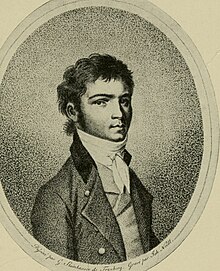Piano Sonata No. 4 (Beethoven)
This article needs additional citations for verification. (June 2016) |

Ludwig van Beethoven's Piano Sonata No. 4, in E♭ major, Op. 7, sometimes nicknamed the Grand Sonata, is dedicated to his student Babette, the Countess Keglevics.[1][2] This piano sonata was composed in Bratislava, in 1796, in November, during his visit of Keglevich Palace in Bratislava.[citation needed] Beethoven named it Great Sonata, because it was published alone, which was unusual for the time.
Along with the Hammerklavier Sonata, it is one of the longest piano sonatas of Beethoven.[3][1] A typical performance lasts about 28 minutes.
Structure[]
The sonata is in four movements:
- Allegro molto e con brio, 6
8 - Largo, con gran espressione, 3
4 in C major - Allegro, 3
4; "Trio" in E♭ minor - Rondo: Poco allegretto e grazioso, 2
4
Analysis[]
I. Allegro molto e con brio[]

The first movement is in sonata form.[4]
II. Largo con gran espressione[]

The second movement is in ternary form.[4]
III. Allegro[]

The third movement is in scherzo and trio form.[4]
IV. Rondo: Poco allegretto e grazioso[]

The fourth movement is in rondo form.[4]
References[]
- Notes
- ^ Jump up to: a b McCallum 2007, p. 8
- ^ Hewitt 2006, p. 7
- ^ Hewitt 2006, p. 6
- ^ Jump up to: a b c d "Beethoven: Piano Sonata No.4 in E♭ major Analysis".
- Sources
- Hewitt, Angela (2006). Liner Notes to Beethoven: Piano Sonatas Opp 10/3, 7 & 57 (PDF) (CD). Hyperion Records. CDA67518.
- McCallum, Peter (2007). "Program notes - Gerhard Oppitz performs Beethoven" (PDF). Sydney Symphony Orchestra. Archived from the original (PDF) on 2015-03-21. Retrieved 2016-06-21.
External links[]
- Piano Sonata No. 4: Scores at the International Music Score Library Project
- A lecture by András Schiff on Beethoven's piano sonata, Op. 7
- For a public domain recording of this sonata visit Musopen
- "Op. 7 - The Beethoven Sonatas". World of Beethoven.com. 5 September 2009. - Discussion and analysis
- "Piano Sonata No.4, Op. 7: Creation History & Music Criticism". Raptus Association. Archived from the original on 2017-03-19. Retrieved 2016-06-20.
- European Archive Copyright-free LP recording of the Sonata no.4 op.7 in E♭ major by Hugo Steurer, piano at the European Archive (for non-American viewers only).
- Piano sonatas by Ludwig van Beethoven
- 1796 compositions
- Compositions in E-flat major
- Music with dedications
